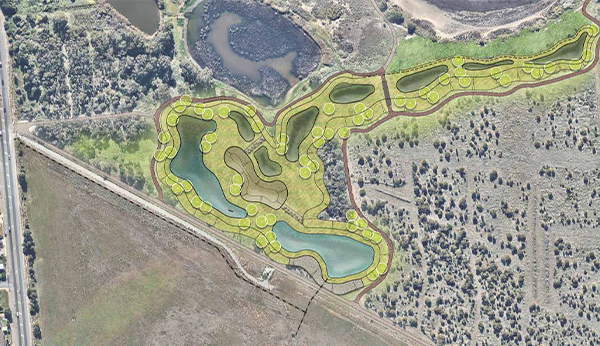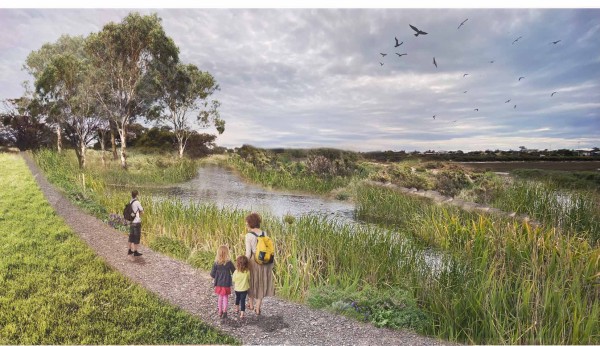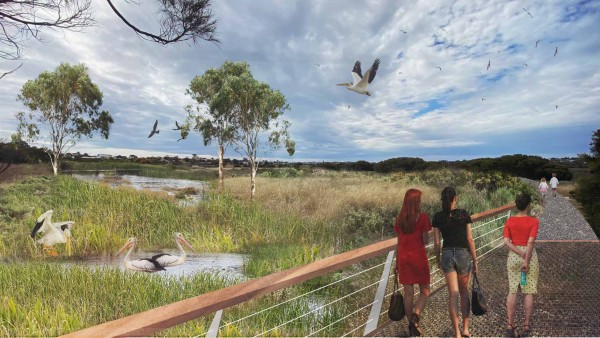Onkaparinga River Recreation Park Wetland
A new wetland is going to be constructed in the Onkaparinga River Recreation Park
The innovative design provides a sustainable, site-specific response to create long-term benefits for the environment and community. Designed by leading consultants WGA, the project delivers best practice water sensitive design for a wetland system that achieves on leading biodiversity habitat, effective stormwater management, and high quality, usable open space.

Biodiversity and Habitat
The wetlands compliments to a more complex ecosystem within the Onkaparinga River Recreation Park, creating greater biodiversity and a range of habitats for a large variety of flora and fauna.
The system respects the ecology of the Port Noarlunga Reef and Onkaparinga River Sanctuary Zones. Stormwater entering the wetlands from the Port Noarlunga South residential development is detained on-site during peak rainfall events and then slowly released through a porous rock weir to the flood zone south of the Onkaparinga River.
The stormwater entering the wetland from the urban catchment largely creates a freshwater aquatic system. However, it becomes a more brackish aquatic wetland close to the river’s flood plains and estuary.
Revegetation throughout the wetlands and open space will also extend the butterfly habitat being restored by Department of Environment and Water on adjacent land. The plan takes care to minimise the impact on the large trees on site.

Water Quality
The wetlands are based on best practice Australian design guidelines, and they meet the Environment Protection Agency (EPA) requirements to a high level.
The design includes a system of deep and shallow pools, wet and dry marshes, flood plain areas, and rock spillways to ensure the wetland is robust and sustainable. This feature is the first of its kind in South Australia.
A Gross Pollutant Trap will catch litter and sediments from the urban catchment. This will allow easy maintenance to clean the rubbish and to provide further protection to the wetland system, extending its life span.
Revegetation of the new wetland uses local indigenous species to respect the park and its environment. Aquatic and terrestrial species are selected to suit the variety of zones that will be created.
Flood Mitigation
The system features ‘soft engineering’ ideas to help control flooding and erosion. These include a series of rock spillways and a discharge pit to control water levels. Rock ‘riffles’ control the flow of changing water levels. An innovative porous rock weir contains a mix of large rocks, rock ballast, compacted soils and native sedge species.
Community Enjoyment
The wetlands create a habitat for birds, frogs, lizards and insects. It’s an area for peaceful relaxation. Sensory learning is also important for children’s development, offering them informal nature play. Citizen scientists of all ages can observe and monitor the natural environment. Birdwatching is popular, with different species attracted by different habitat zones.

Access and Recreation
The wetlands significantly expand the size and quality of local open space for public recreation. More than a kilometre of walking trails and boardwalks create a trail loop through the wetlands and connect with existing trails in the Onkaparinga River Recreation Park. Walkers can enter the wetlands from two points at the southern end.
Future Maintenance
The wetland system is designed to allow easy access for ongoing maintenance. From time to time, sediment and rubbish need to be removed from the Gross Pollutant Trap, as well as sediment from the wetland inlet pond. Outdoor crews can also access the native vegetation areas. Maintenance is undertaken by the City of Onkaparinga.
Summary
The wetland system is making a significant contribution towards better community access to the Onkaparinga River Recreation Park. It will provide a seamless connection between the proposed residential development and the recreation park, while protecting the natural environment for future generations.
*Disclaimer images are illustrative only and subject to change.







